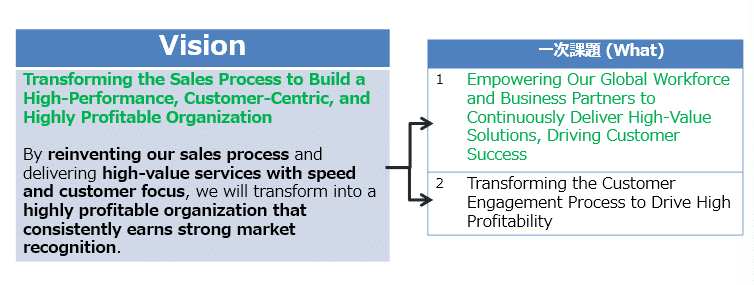
Project Leadership: How to Develop a DX Strategy in 3 Months - Part 3 Generate Issue Tree from Vision statement✨
DX, or Digital Transformation, refers to leveraging digital technology to fundamentally innovate business models and operations.
One of the most prominent examples is Amazon’s automated warehouse system, which integrates robotics and AI to streamline picking and packing processes. This has drastically improved efficiency, reducing the time from order placement to shipment.
This is a classic case of DX in action—utilizing digital technology to fundamentally transform business operations.
Now, imagine your CEO or leadership team approaches you and says:
"We need a DX strategy—can you create one?"
What would you do?
My Experience in Business Transformation
I spent my career as a consultant at IBM, where I led and successfully delivered over 70 business transformation projects for clients. After retiring from IBM, I established myself as an independent consultant, specializing in business reform and project leadership training.
Today, I’ll walk you through a structured approach to developing a DX strategy in just 3 months, with a focus on a key component:
⏩ Identifying Key Reform Points ✨
⏩What is a Business Transformation Strategy?
Let’s assume your company is facing one of the following challenges:
Competitive pressure is increasing, and your company risks losing market share.
Customer orders are declining, affecting revenue.
Your core products are struggling to generate sales.
To address these issues, a structured transformation plan is essential—one that reassesses and redesigns business processes, organizational structure, and operational frameworks.
Now, if you were tasked with leading this transformation project and given just 3 months, how would you approach it?
⏩ A Proven 3-Month Approach to Business Transformation Planning
Based on my experience driving 70+ successful projects, I recommend the following two-phase approach over a 3-month period:

For a detailed breakdown of the Analysis Phase, refer to my previous article:
For insights on structural challenges, check out:
Today, we will focus on the next critical step—defining innovation points.
⏩ What Are Innovation Points?
Once you’ve:
✅ Understood the company’s external environment
✅ Conducted a thorough current-state analysis
✅ Identified structural bottlenecks
The next step is to define the desired future state and establish the necessary transformation steps.
This is done in three key stages:
✅ Defining the Vision – Clearly articulate the aspirational future state of the company.
✅ Identifying Primary Issues (What?) – Determine key initiatives required to achieve the Vision (typically 10 major themes).
✅ Formulating Hypotheses for Execution (How?) – Develop a structured, hypothesis-driven plan to transition from the current state (As-Is) to the future state (To-Be).
Example: A Global Sales Process Transformation
Let’s take a real-world example from a global corporation, where we structured the transformation process as follows:
Vision Statement (Where do we want to go?)
Primary Challenges (What needs to change?)
Execution Hypotheses (How do we implement it?)

By structuring the reform plan this way, the entire team aligns on a shared understanding before moving into execution.
⏩ How to Define a Vision for DX
A quick Google search or ChatGPT query will yield countless methodologies for defining a corporate transformation Vision.
However, after working with numerous companies on transformation projects, I have developed a simple, yet effective method that allows teams to draft a Vision in just one hour.
Case Study: Vision Creation in 60 Minutes
In July 2024, I facilitated a DX strategy session at Company A, where we developed a Vision draft in just one hour.

By collecting high-priority keywords from stakeholders, identifying core themes, and synthesizing them into a structured statement, the team was able to rapidly align on a strategic Vision.

⏩ How to Identify Issue Trees out of Vision statement?
Once the Vision is established, the next step is to identify key strategic initiatives needed to realize it.
1️⃣ The project team reviews the Vision and brainstorms:
What must we accomplish to reach this Vision?
What are the critical gaps today?
2️⃣ Each member writes their insights on sticky notes.
3️⃣ These ideas are clustered and categorized based on common themes.
4️⃣ The team prioritizes the most impactful initiatives.
For example, in a sales process transformation, we segmented the Vision statement into distinct green and black sections, each representing a different strategic priority.

By following this collaborative, structured approach, companies can ensure they identify the right strategic challenges before moving into execution.
⏩ How to Formulate Execution Hypotheses (How?)
The next step is to define how to execute each primary challenge.
The team must brainstorm potential solutions using best practices, competitive benchmarks, and external expertise.
Consulting external thought leaders or leveraging AI-driven insights can be highly effective in refining strategic options.

This step is critical because it determines how the company gains a competitive edge.
Instead of just incremental improvements, breakthrough ideas require bold, innovative thinking.
Summary: Driving a Successful Business Transformation
In this article, we focused on the key phase of business transformation planning—Vision to Challenge Breakdown.

For anyone involved in business reform—whether to improve customer satisfaction, enhance efficiency, or drive operational excellence—this structured approach ensures:
✔️ A clear Vision that aligns all stakeholders
✔️ A structured challenge breakdown (What needs to change?)
✔️ An execution framework (How to implement it?)
By following this collaborative methodology, companies can ensure alignment, foster a shared understanding, and drive successful transformation efforts.
If your organization is considering a DX initiative, I highly recommend using this structured approach to ensure a high-impact, strategically aligned transformation.
🚀 Digital Transformation begins with a clear, structured Vision—one that your entire team can rally behind. Try it out today. 😊
この記事が気に入ったらチップで応援してみませんか?

